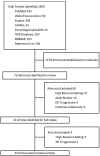Scoping Review of Pediatric Early Warning Systems (PEWS) in Resource-Limited and Humanitarian Settings
- PMID: 30671424
- PMCID: PMC6331420
- DOI: 10.3389/fped.2018.00410
Scoping Review of Pediatric Early Warning Systems (PEWS) in Resource-Limited and Humanitarian Settings
Abstract
Pediatric Early Warning Systems (PEWS) aim to identify hospitalized children at increased risk of deterioration by assigning a score based on vital signs and clinical status and guiding interventions using a response algorithm to improve outcomes. When implemented with quality improvement methodology, these systems have been shown to be effective in high-resource settings and have the potential to improve the care of children in humanitarian and resource-limited settings (RLS). The purpose of this review is to summarize the current evidence for use of PEWS in RLS and identify areas for further research. A review of the current PEWS literature in RLS was performed using Web of Science, PubMed, Scopus, Cumulative Index of Nursing and Allied Health Literature (CINAHL), EMBASE, Portal Regional da BVS, and TRIP Database. While there is limited research available on this topic, eight studies on the use of PEWS, or a PEWS score in a pediatric population in low- or middle-income countries were identified. Two studies assessed the clinical effect of implementation of PEWS; one reported a reduction in clinical deterioration events and the other a reduction in mortality. The remaining studies assessed the association of a PEWS score with signs of clinical deterioration or mortality without a response algorithm. Further research on the impact of PEWS implementation on inpatient care and outcomes in RLS is needed.
Keywords: hospital mortality; humanitarian pediatrics; pediatric early warning system; quality of care; resource-limited settings.
Figures
References
-
- Bell D, Mac A, Ochoa Y, Gordon M, Gregurich MA, Taylor T. The texas children's hospital pediatric advanced warning score as a predictor of clinical deterioration in hospitalized infants and children: a modification of the PEWS tool. J Pediatr Nurs. (2013) 28:e2–9. 10.1016/j.pedn.2013.04.005 - DOI - PubMed
Publication types
LinkOut - more resources
Full Text Sources


